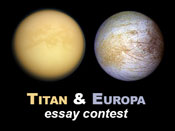Instrument Development
 Deep UV Native fluorescence mapping instrument in a preliminary field test in Mojave, CA |
Ultimately, the presence of life on icy worlds is of little scientific interest if robotic and human explorers cannot discover the inhabitants. The search for life requires instruments and techniques that can detect biosignatures (substances or elements that provide scientific evidence of past or present life) in space. The Icy Worlds team is working to advance this capability by developing a "path to flight" or astrobiology instrumentation that has not yet reached a technology readiness level adequate for flight.
The investigations are comprehensive- each building upon each other based upon previous investigations and the data they have provided over a long period of time. If we are to discover life on another world, then there must be some detectable signature of that life. In order for a detectable biosignature to persist, something of, or from, the original organism must have survived in the surface ice. For that to occur, various processes beneath the surface must have provided for habitable conditions and a means to transport the organism to the surface.
